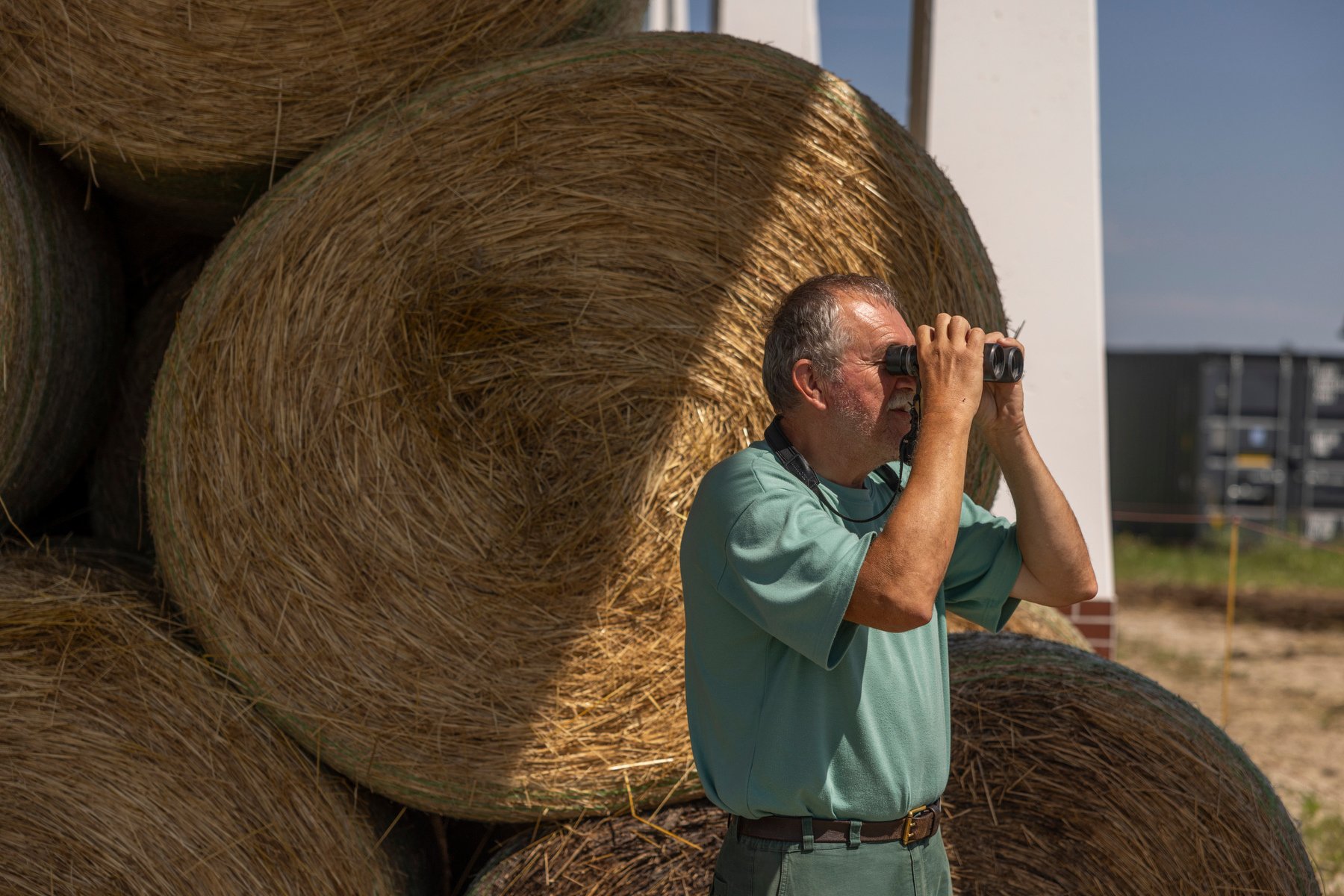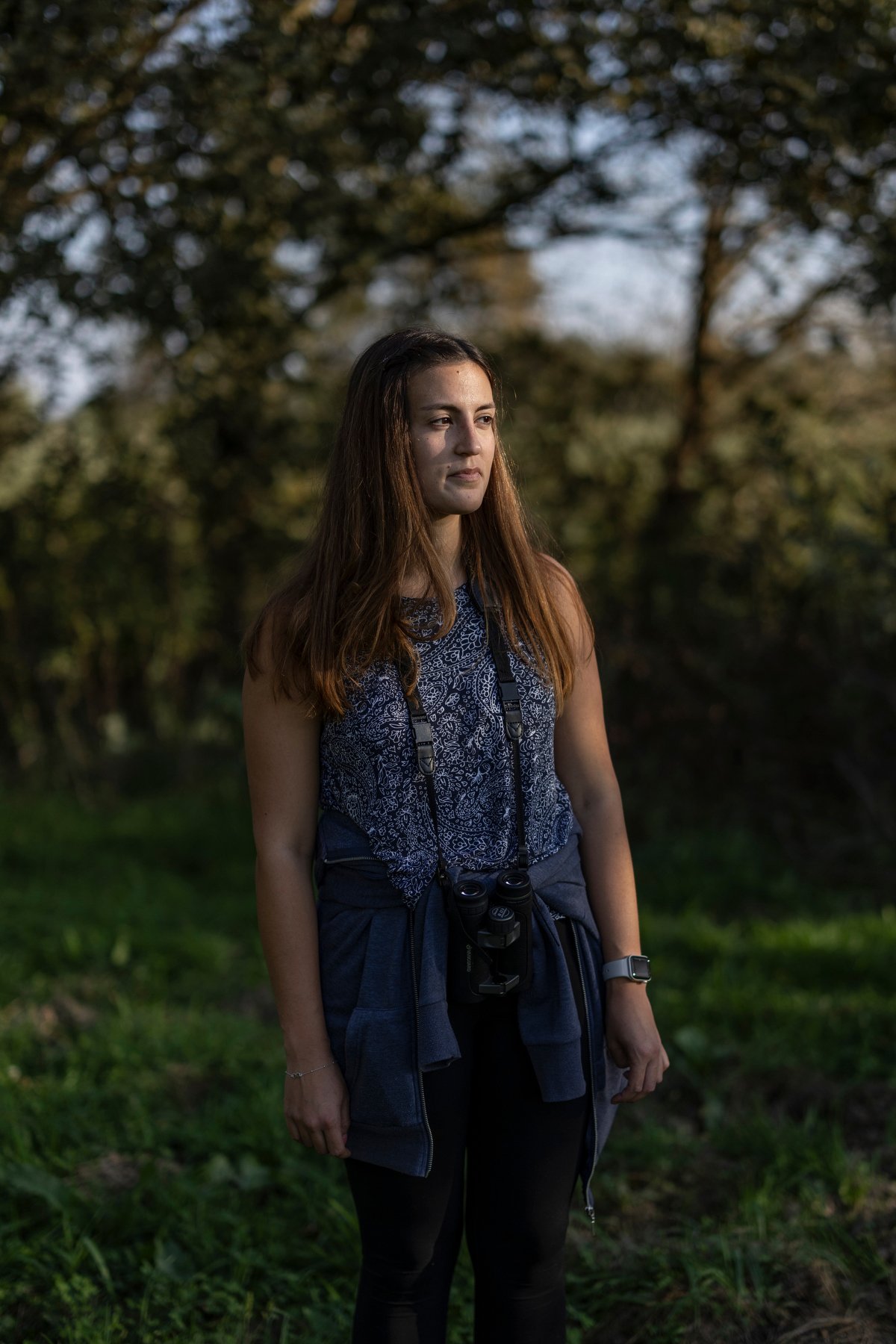
SLOVENIA. August 2024. Prekmurje. A rainbow arches over the fields in Prekmurje, a region within Slovenia’s UNESCO Biosphere Reserve. The area experienced significant flooding in 2023 due to unusually heavy rainfall and rising water levels in the Mura River. These extreme weather events, linked to changing climate patterns, have increasingly stressed the river system, leading to seasonal flooding that disrupts local agriculture and impacts nearby communities.

CROATIA, October 2024. Nikola Bataković from Hrvatske vode (Croatian Waters) presents a map highlighting rewilding projects near Osijek, Croatia. Rewilding efforts in Croatia are supported by significant European funding, including initiatives like the LIFE which have provided substantial financial backing for nature-based projects across the region.

SLOVENIA. August 2024. Mura River. A kayaker searches for petrified wood along the riverbank of the Mura River, a rare natural find in this area where erosion occasionally reveals ancient remnants.

HUNGARY. August 2024. Letenye, Balaton-Felvidék National Park. András Lelkes, a park ranger, plays a vital role in monitoring the park’s ecosystems, preserving natural and cultural heritage, and collaborating with local communities to ensure that park management aligns with conservation goals. His work, alongside other rangers, also includes guiding visitors, conducting research, and enforcing sustainable practices to help preserve the area’s unique landscape and biodiversity.

SERBIA. September 2024. Near Sombor. Biologist and ornithologist Nenad Spremo extracts a reed warbler from a mist net for banding. Nenad has been studying birds for a decade and bands four to five thousand birds annually. Over the past ten years, he has banded around 20,000 birds, making him the record holder in Serbia. Bird banding allows him to track migration patterns and monitor population health.

HUNGARY. August 2024. Réka Schuster, Communications Officer at WWF Hungary, plays a crucial role in promoting conservation efforts, including the protection of biosphere reserve areas. WWF Hungary focuses on preserving riverine and floodplain ecosystems, as well as natural forests, which are vital for biodiversity and ecosystem services.

CROATIA. August 2024. Village of Zmajevac, one of the many former German villages in the region. This area was once home to a significant population of Podunavski Nemci, ethnic Germans who settled along the Danube River, along with Hungarian communities, particularly in what is now the eastern part of Croatia, Serbia, and Hungary. Following World War II, many of these German and Hungarian communities were displaced, but their legacy still shapes the cultural landscape of the region today.

SLOVENIA. October 2023. Anja Cigan, a researcher at the Institute for Nature Conservation of Slovenia, observes migratory birds along the Mura River—a vital habitat now under threat. Climate change is disrupting migration patterns, with droughts and floods endangering nesting sites and altering ecosystems. Her work underscores the urgent need to protect these fragile ecosystems before irreversible damage occurs.

CROATIA. October 2023. Hrvoje Domazetov, a ranger in Kopački Rit Nature Park, Croatia, faces the ongoing challenge of protecting one of Europe’s most vital wetland ecosystems. Kopački Rit, a critical breeding and nesting ground for endangered bird species and a key stopover for migratory birds along the Danube and Drava rivers, is under constant threat from human activity and environmental degradation. Hrvoje has highlighted how government corruption and political favors often undermine conservation efforts, with authorities turning a blind eye to violations for short-term gains.

SERBIA. September 2024. A roma tombstone near the village of Bački Monoštor in Serbia, a settlement shaped by its strategic location near the Danube. The first settlers in the 17th century were Hungarians, followed by Catholic Croats from Slavonia and Bosnia. Over the centuries, the village became home to a diverse mix of ethnic groups, including Germans and finally Serbs. While much of this multicultural past has faded, the Roma community remains a significant part of the local population today.

SERBIA. September 2024. Along the Danube River. A lumberjack cuts down a white poplar as part of Vojvodina Šume’s forestry activities. Although poplars are not highly valued for their wood, their fast growth makes them popular for monoculture plantations. Serbia promotes these plantations as sustainable forestry, using this claim to bolster its candidacy for EU membership. However, critics argue that this approach prioritizes resource extraction over true environmental sustainability, with monocultures contributing to deforestation and undermining natural biodiversity.

SLOVENIA. August 2024. Villagers in Prekmurje, which means 'Over the Mura River,' pose for a photo as a storm approaches. The Mura River has long been central to life in this Slovenian region, once home to over 69 river mills that drove the local economy. The connection between the people and the river remains strong, shaping their culture and livelihoods.

SERBIA. September 2024. Along the Danube River. A lumberjack cuts down a white poplar as part of Vojvodina Šume’s forestry activities. Although poplars are not highly valued for their wood, their fast growth makes them popular for monoculture plantations. Serbia promotes these plantations as sustainable forestry, using this claim to bolster its candidacy for EU membership. However, critics argue that this approach prioritizes resource extraction over true environmental sustainability, with monocultures contributing to deforestation and undermining natural biodiversity.

SERBIA. August 2024. Swimmers in Bački Monoštor enjoy the Great Bačka Canal, a historic waterway connecting the Danube and Tisza rivers in Serbia. Built in the late 18th century, the canal has long served as a vital artery for transportation, agriculture, and recreation. However, local industries, enabled by corruption, often fail to meet water treatment standards, posing a significant threat to the canal’s ecosystem. Polluted waters endanger swimming, fishing, and farming, undermining the health of both the environment and the communities that depend on it.

SERBIA. September 2024. On the Danube near Apatin (Serbia), sport fishing is very popular, and freshwater fish often feature on the menu. Catfish, pike, carp, and zander are common catches. In September, the water level of the Danube was very low, causing the shipping channels for large transport and tourist vessels to narrow significantly.

SERBIA. September 2024. Dušan Medić is one of three commercial fishermen on the Danube River near Apatin in Serbia. The Danube supports a diverse range of fish species and is crucial for the local economy and cultural heritage, with fishing being a centuries-old tradition. However, it also faces environmental challenges, making sustainable practices essential for maintaining the river's ecosystem and supporting future fisheries.

CROATIA. September 2024. The Danube River in Croatia is home to a rich diversity of bird species, with wetlands and riverbanks providing vital habitats for migratory and resident birds alike. However, intensive farming practices in the region are threatening these populations, with habitat destruction, pesticide use, and pollution leading to increased bird mortality.

SERBIA. September 2024. Following formal logging operations, local residents are permitted to collect leftover wood from the forest. This practice helps manage forest waste while providing a complementary source of fuel for heating during the winter months, supporting community needs.

SERBIA. September 2024. Bojan Tadić, a specialist for protected areas and environmental protection, is on patrol along the Danube River. He emphasizes the problem of illegal hunting and fishing, particularly off-season fishing and overfishing. These activities can significantly harm the fish population in the river, disrupting the delicate ecosystem and threatening the sustainability of local species.



















